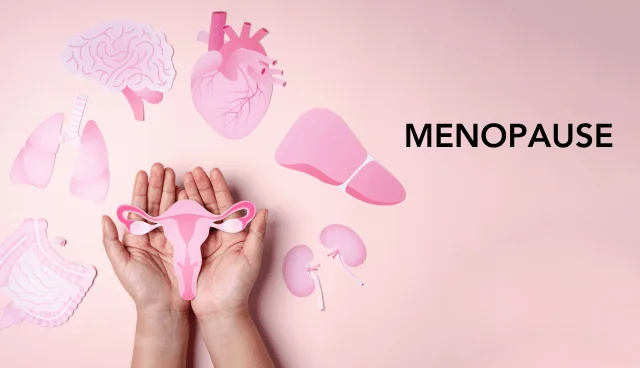
Navigating Menopause: Understanding Symptoms and Treatment Options
The menopause, a normal biological process, indicates the end of a woman’s fertile years. It’s a significant milestone in a woman’s life and can bring about a variety of physical and emotional changes. In this blog, we will delve into the topic of menopause, discussing menopause symptoms, perimenopause, night sweats, hormone replacement therapy, and other related keywords. We’ll explore the signs of menopause, early menopause, menopause treatments, and premature menopause, all while sharing insights and advice to help you better understand and manage this transformative phase.
The Basics of Menopause
Menopause is a term that is commonly used, but what does it really mean? Menopause is the point in a woman’s life when she stops menstruating permanently, typically occurring in her late 40s or early 50s. It signifies the end of the reproductive phase and is confirmed after 12 consecutive months without a menstrual period. However, menopause is not an abrupt event; it is preceded by a transitional phase known as perimenopause.
Perimenopause, a stage that can begin in one’s 40s or even earlier, is when the body starts to produce fewer hormones like estrogen and progesterone. During this time, women may experience irregular periods, mood swings, and other menopause symptoms. Perimenopause is often the precursor to full-blown menopause.
Common Menopause Symptoms
Menopause is a unique experience for every woman, but some symptoms are commonly associated with this life stage. Let’s take a closer look at these menopause symptoms:
1. Hot Flashes:
One of the most recognizable symptoms of menopause is hot flashes. These sudden, intense feelings of warmth can be accompanied by sweating and flushing of the face and neck.
2. Night Sweats:
Similar to hot flashes, night sweats can disrupt sleep patterns. They involve sudden episodes of sweating during the night, often causing discomfort and sleep disturbances.
3. Mood Swings:
Hormonal changes can lead to mood swings, irritability, and emotional ups and downs. These mood swings can be challenging to manage but are a common part of the menopausal experience.
4. Irregular Periods:
As mentioned earlier, perimenopause often brings irregular periods. These can vary in frequency and intensity, making it difficult to predict when menstruation will occur.
5. Vaginal Dryness:
Decreased estrogen levels can result in vaginal dryness and discomfort during intercourse. It’s essential to address this issue to maintain sexual health and intimacy.
6. Weight Gain:
Many women notice changes in their body composition during menopause, with a tendency to gain weight, particularly around the abdomen.
7. Sleep Disturbances:
Night sweats and other menopause-related symptoms can make it challenging to get a good night’s sleep, leading to fatigue and other health issues.
8. Memory and Concentration Issues:
Some women report cognitive changes, such as memory lapses and difficulty concentrating, during menopause.
9. Hair and Skin Changes:
Changes in hormone levels can affect the condition of your hair and skin. This may include hair thinning, dry skin, and increased facial hair growth.
10. Urinary Problems:
Menopause can lead to urinary issues like incontinence or frequent urination due to changes in the urinary tract.
Signs of Menopause
Recognizing the signs of menopause is crucial for understanding and managing this life transition. Apart from the common symptoms mentioned above, there are other signs that indicate the onset of menopause. These include:
1. Changes in Menstrual Cycle:
Irregular periods or a complete absence of menstruation for at least a year.
2. Age:
Menopause typically occurs between the ages of 45 and 55, with the average age being around 51 in the United States.
3. Family History:
A family history of early menopause may increase the likelihood of experiencing menopause at a younger age.
4. Hormonal Changes:
Blood tests can confirm hormonal changes, such as decreased estrogen and elevated follicle-stimulating hormone (FSH) levels.
5. Bone Health:
Reduced estrogen levels can lead to decreased bone density, which may be detected through bone density scans.
Understanding these signs can help women prepare for menopause and seek appropriate care if needed.

Early Menopause and Its Symptoms
While menopause typically occurs in a woman’s late 40s or early 50s, some women experience early menopause. Early menopause, defined as menopause before the age of 40, can be accompanied by its unique set of symptoms. Let’s explore early menopause symptoms and why it occurs:
1. Hot Flashes and Night Sweats:
Just like menopause at the typical age, early menopause can bring on hot flashes and night sweats.
2. Irregular Periods:
Women experiencing early menopause may notice irregular periods or a sudden cessation of menstruation.
3. Emotional Changes:
Mood swings and emotional ups and downs can be more pronounced in cases of early menopause.
4. Vaginal Dryness:
Vaginal dryness and discomfort can also occur earlier than expected.
5. Bone Health:
Early menopause can pose a higher risk to bone health, increasing the likelihood of osteoporosis.
6. Fertility Concerns:
Early menopause can lead to infertility, which can be emotionally challenging for women who had plans for future pregnancies.
Managing Menopause
The good news is that there are various ways to manage and alleviate menopause symptoms. Here are some strategies and menopause treatments to consider:
1. Lifestyle Changes:
Adopting a healthy lifestyle can make a significant difference. Regular exercise, a balanced diet, and stress management techniques can help reduce the severity of symptoms.
2. Hormone Replacement Therapy (HRT):
HRT involves the use of estrogen and, in some cases, progesterone to replace the hormones that the body is no longer producing in sufficient quantities. This can help alleviate symptoms like hot flashes, mood swings, and vaginal dryness. HRT should, however, be examined with a physician because it is not suitable for everyone.
3. Alternative Therapies:
Some women find relief through alternative therapies like acupuncture, herbal supplements, or mind-body practices like yoga and meditation.
4. Vaginal Estrogen:
For vaginal dryness and discomfort, vaginal estrogen treatments, such as creams, rings, or tablets, can be effective.
5. Prescription Medications:
In some cases, prescription medications may be recommended to address specific symptoms like mood swings or sleep disturbances.
6. Bone Health:
To maintain bone health, calcium and vitamin D supplements, along with weight-bearing exercises, are often recommended.
7. Emotional Support:
Don’t underestimate the power of emotional support. Talking to friends, family, or a therapist can help you navigate the emotional challenges that can come with menopause.
Premature Menopause
Premature menopause, sometimes referred to as premature ovarian insufficiency (POI), occurs when menopause sets in before the age of 40. This condition can have a profound impact on a woman’s life, and it’s essential to recognize the signs and seek appropriate care. Symptoms of premature menopause may include:
1. Hot Flashes and Night Sweats:
These classic menopause symptoms can occur earlier than expected in cases of premature menopause.
2. Infertility:
One of the most significant challenges of premature menopause is infertility. Women with POI often struggle to conceive.
3. Emotional Impact:
Dealing with the diagnosis of premature menopause can be emotionally taxing. It’s essential to seek support from healthcare professionals and support networks.
4. Bone Health:
Like early menopause, premature menopause can pose a higher risk to bone health, increasing the likelihood of osteoporosis.
5. Hormone Replacement Therapy:
HRT is often recommended for women with premature menopause to address hormonal deficiencies and alleviate symptoms.
Symptoms of Menopause at 46
Experiencing menopause at the age of 46 is not uncommon. In fact, it falls within the typical age range for menopause. If you find yourself facing menopause at 46, you may encounter a mix of the symptoms mentioned earlier. However, each woman’s experience is unique, and your specific symptoms may vary.
It’s crucial to consult with a healthcare provider to discuss your symptoms and explore appropriate treatment options. Whether you’re dealing with hot flashes, night sweats, mood swings, or other menopause-related challenges, there are ways to manage and alleviate these symptoms to improve your overall quality of life.
Conclusion
In conclusion, menopause is a natural phase of a woman’s life, marking the end of her reproductive years. It brings about various physical and emotional changes, including common symptoms like hot flashes, night sweats, mood swings, and irregular periods. Recognizing the signs of menopause, including early menopause and premature menopause, is essential for seeking appropriate care and support.
Managing menopause involves a combination of lifestyle changes, hormone replacement therapy, alternative therapies, and emotional support. It’s essential to work closely with healthcare providers to tailor a treatment plan that addresses your unique needs and symptoms.
Remember that menopause is a journey that every woman experiences differently. While it may present challenges, it can also be a time of growth, self-discovery, and empowerment. Embrace this phase of life, seek support when needed, and focus on maintaining your overall health and well-being as you navigate the changes that menopause brings.
In summary, menopause is a significant life transition that can be managed with the right knowledge and support. By understanding menopause symptoms, signs, and treatment options, women can approach this phase with confidence and grace. Menopace is a natural part of a woman’s life journey, and with the right resources, it can be navigated successfully.
